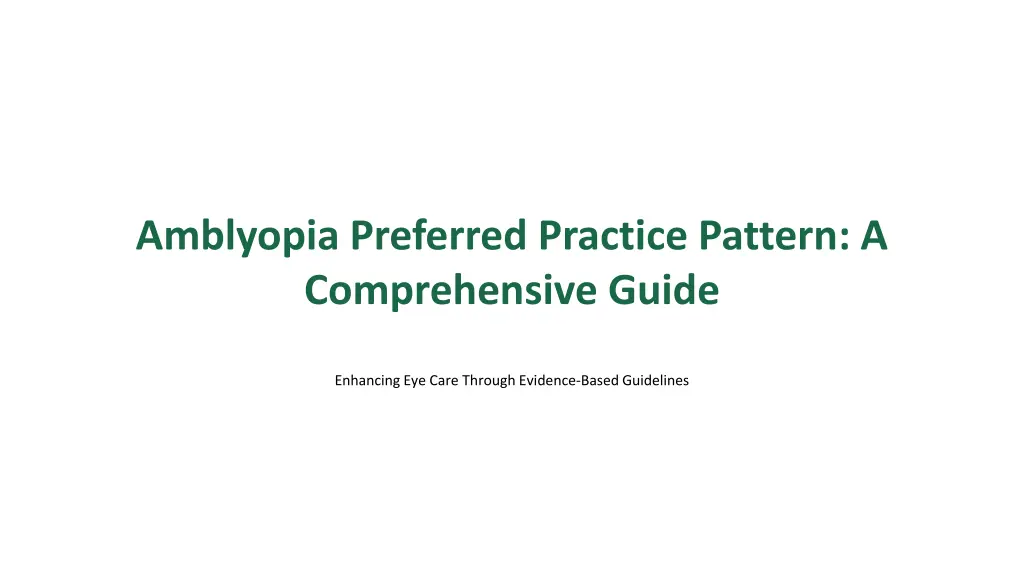
Comprehensive Guide to Amblyopia Preferred Practice Pattern
Discover a comprehensive guide on Amblyopia Preferred Practice Pattern (PPP), a critical resource for managing amblyopia in children. Learn about the development process, key contributors, and the importance of evidence-based guidelines in addressing this prevalent vision disorder.
Download Presentation

Please find below an Image/Link to download the presentation.
The content on the website is provided AS IS for your information and personal use only. It may not be sold, licensed, or shared on other websites without obtaining consent from the author. If you encounter any issues during the download, it is possible that the publisher has removed the file from their server.
You are allowed to download the files provided on this website for personal or commercial use, subject to the condition that they are used lawfully. All files are the property of their respective owners.
The content on the website is provided AS IS for your information and personal use only. It may not be sold, licensed, or shared on other websites without obtaining consent from the author.
E N D
Presentation Transcript
Amblyopia Preferred Practice Pattern: A Comprehensive Guide Enhancing Eye Care Through Evidence-Based Guidelines
01 Introduction to Amblyopia Table of Contents 02 Development of the Amblyopia PPP 03 Key Contributors 04 Quality Assurance Process 05 Importance of Evidence-Based Guidelines 06 Amblyopia Screening and Diagnosis 07 Treatment Approaches 08 Follow-Up and Monitoring 09 Conclusion and Future Directions 10 Thank You!
1 Introduction to Amblyopia Amblyopia, often referred to as 'lazy eye,' is a prevalent vision disorder in children that affects depth perceptionand visual acuity. It typically occurs when one eye fails to achieve normal visual acuity, leading to visual impairment if not treated promptly. Awareness and early intervention are critical to prevent long-term visual compromise and ensure optimal development in children. In this presentation, we will explore the guidelines developed by the American Academy of Ophthalmology for addressing amblyopia and its management. Let's dive into the Amblyopia PreferredPractice Pattern (PPP) and understandits significance.
2 Development of the Amblyopia PPP The Amblyopia Preferred Practice Pattern guidelines were meticulously crafted by a panel of experts in Pediatric Ophthalmology and Strabismus. The panel included distinguished professionals who collaboratively reviewed multiple drafts and conducted discussions to reach a consensus. Their collective expertise ensures that the guidelines are both comprehensive and relevant to the current clinical landscape. This collaborative effort underscores the importance of teamwork in developing effective clinical guidelines for healthcareprofessionals. Let s recognize the dedicated individuals behindthese valuable guidelines.
3 Key Contributors The Amblyopia PPP panel from 2021 to 2022 included prominent figures: Oscar A. Cruz, MD, Michael X. Repka, MD, MBA, and others. Consultants and methodologists contributed their insights to enrich the guideline development process, ensuring evidence-based practices are highlighted. The Preferred Practice Patterns Committee played a crucial role in reviewing and discussing the guidelines to finalize them for publication. Each member s commitment reflects a shared goal: to enhance pediatric eye care through established best practices. Let s applaudtheir efforts in setting a standardof care in amblyopia management.
4 Quality Assurance Process The guidelines were developed without external financial support, ensuring unbiased and objective recommendations. A rigorous review process included external experts and stakeholders who provided feedback to enhance the document's clarity and utility. Transparency in the development process fosters trust in the guidelines and encourages their adoption in clinical practice. Quality assurance is vital for maintaining high standards in patientcare and professional practice. Understanding this process strengthens our confidence in implementing these guidelines.
5 Importance of Evidence-Based Guidelines Evidence-based guidelines are essential for standardizing care and ensuring best practices in the management of amblyopia. They provide healthcare professionals with clear recommendations based on the latest research and clinical findings. Adopting these guidelines minimizes variability in practice, enhancing patientoutcomes. Furthermore, it supports healthcare providers in making informed decisions for patientcare. The significance of these guidelines cannot be overstated.
6 Amblyopia Screening and Diagnosis Early detection of amblyopia is critical; screening should begin in infancy and continue through early childhood. Standardizedvision screening protocols help identify children at risk of amblyopia promptly. Use of standardized tests ensures that cases of amblyopia are diagnosed effectively and reliably. Timely diagnosis allows for swift intervention, which is crucial for successful treatmentoutcomes. Remember, the sooner we act, the better the chance for a positive result.
7 Treatment Approaches The management of amblyopia may include patching therapy, atropine drops, and vision therapy, tailored to the child's needs. Patching the stronger eye encourages use of the weaker eye, promoting visual development. Atropine drops can serve as an alternative to patching, providing options for families. Vision therapymay also be employed to improve both visual acuity and coordination. An individualized approach is critical for effective treatment.
8 Follow-Up and Monitoring Ongoing follow-up is crucial to monitor treatmentprogress and make necessary adjustments. Regular check-ups help in assessing visual acuity and ensuring that interventions are effective. Monitoringcompliance with treatmentprotocols is essential for achieving desired outcomes. Engaging families in the follow-up process enhances adherence and commitment to treatment plans. Let's emphasize the importance of continuity in care.
9 Conclusion and Future Directions The Amblyopia Preferred Practice Pattern serves as a vital tool for practitioners in ensuring best practices in amblyopia care. Future research and feedback from implementation will continue to refine these guidelines to meet evolving clinical needs. By committing to evidence-based care, healthcare professionals can significantly improve outcomes for children with amblyopia. The ongoing collaboration among experts will fuel innovation in pediatric ophthalmology. Together, we can enhance the quality of eye care for future generations.
10 Thank You! Thank you for your attention and dedication to enhancing pediatric eye care. Your commitment to implementing these guidelines is invaluable in fostering better outcomes for children with amblyopia. Let s continue to work together to ensure a brightervision for our future generations. For any furtherquestions or discussions, feel free to reach out. Together, we can make a difference!
